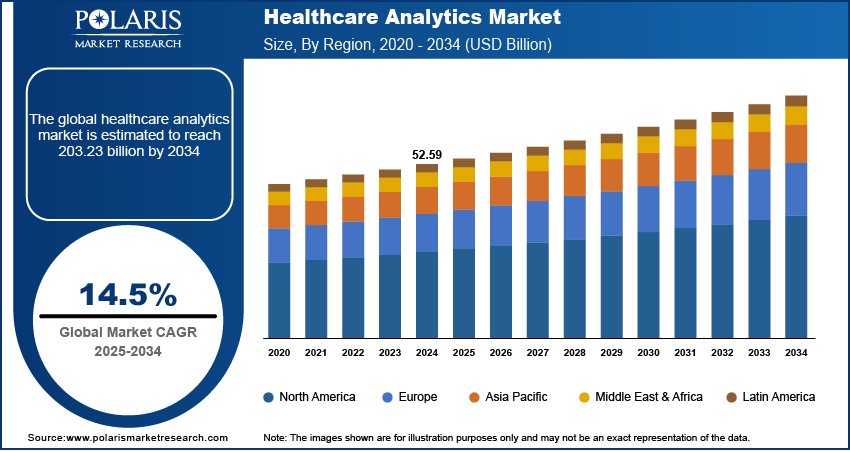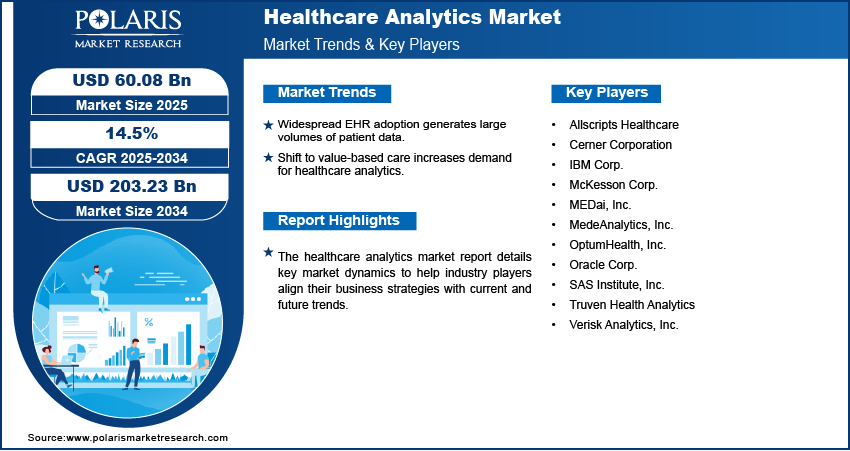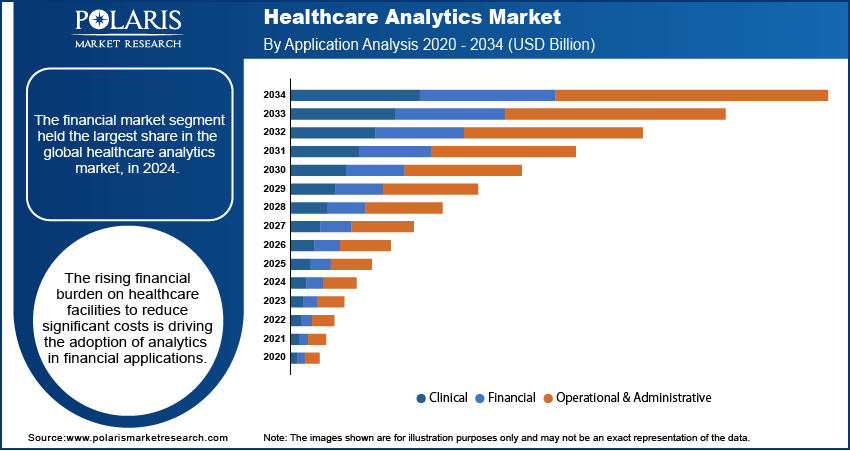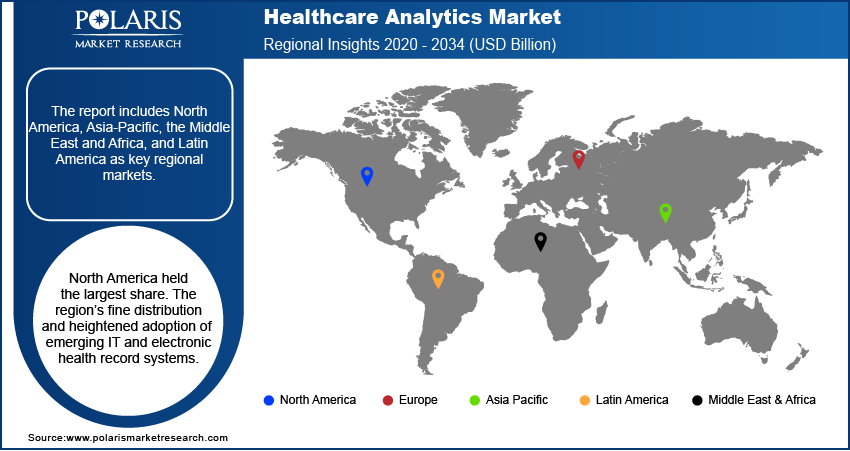
Healthcare Analytics Market Share, Size, Trends, Industry Analysis Report
By Type (Descriptive Analytics, Predictive Analytics, Prescriptive Analytics), By Application, By End-Use; By Delivery Mode; By Regions; Segment Forecast, 2025 - 2034
- Published Date:Sep-2025
- Pages: 108
- Format: PDF
- Report ID: PM1795
- Base Year: 2024
- Historical Data: 2020 - 2023
The global healthcare analytics market was valued at USD 52.59 billion in 2024 and is expected to grow at a CAGR of 14.5% during the forecast period. The rising need to reduce healthcare costs, growing prevalence of ever-growing chronic diseases, adoption of analytical services among healthcare stakeholders, and recent advancements in big data and artificial learning are largely responsible for the market growth.
Key Insights
- By type, descriptive analytics held the largest share because it is the first tier of analytics that focuses on analyzing data.
- By application, financial subsegment held the largest share because there is a need to cut down on unnecessary financial costs and increase the profit agility of the financial operations of healthcare organizations.
- By delivery mode, the on-premises held the largest share. This is within the regard where most organizations maintain their records in healthcare analytics.
- By end use, pharmaceutical and biotechnology firms held the largest share because they apply analytics to boost the efficiency of drug development and to intensive research.
- By region, North America held the largest share. The region’s fine distribution and heightened adoption of emerging IT and electronic health record systems.
Industry Dynamics
- The widespread adoption of electronic health records (EHRs) as well as other digital health technologies enables the collection of large volumes of patient information, which needs to be analyzed, hence driving the market growth.
- The adoption of value-based care models has also increased the need for analytics. Healthcare providers are no longer using the fee-for-service model, but are now reimbursed based on the patient’s clinical outcomes.
Market Statistics
- 2024 Market Size: USD 52.59 billion
- 2034 Projected Market Size: USD 203.23 billion
- CAGR (2025-2034): 14.5%
- North America: Largest market in 2024
AI Impact on the Market
- AI is enhancing the accuracy and speed of diagnostic procedures by performing image analysis on X-rays and CT scans to detect conditions.
- By forming customized medicine and treatment schedules, AI is able to improve medical outcomes and decrease adverse side effects.
- The technology has also streamlined the pre- and post-visit processes by automating a range of functions, including appointment booking, patient file management, and billing, thereby increasing organizational productivity and minimizing operational costs.

To Understand More About this Research: Request a Free Sample Report
The healthcare analytics market report details key market dynamics to help industry players align their business strategies with current and future trends. It examines technological advances and breakthroughs in the industry and their impact on the market presence. Furthermore, a detailed regional analysis of the industry at the local, national, and global levels has been provided.
Moreover, rising investment in start-ups, strong government policy support, and increasing partnerships and collaborations in the marketplace have propelled the market growth. For instance, in January 2019, the U.S.-based company has partnered with eQHealth Solutions to strengthen the capabilities of the latter’s analytics domain. The acquired firm was known for its ability to extract valuable insights from both structured and unstructured data from the physician notes, prescription diaries, and coordinator’s health risk assessments.
Industry Dynamics
Growth Drivers
The shift in focus from volume to value-based care and the ongoing pandemic has boosted the adoption of healthcare analytics among healthcare establishments. As per the analysis of Oliver Wyman, in March 2020, the COVID-19 pandemic has encouraged the adoption of analytical solutions for the population at greater risk. The rise in implementation of such solutions has further contributed to manage the potential risks, to deliver meaningful insights, by improving data and analytical services to boost the market growth.

Moreover, companies are intensively focusing on value-based care. As per a report published by IBM, “2019 Payer Analytics Market Trends Report”, payers are adopting analytical services to support the transition from fee for service to value-based care. Furthermore, the availability of pay for reporting, risk, and revenue sharing programs, and pay for performance programs with the providers has led to the rise in investments by the payer groups to understand healthcare needs and risks.
Which future trends are expected to boost the healthcare analytics market during the forecast period?
The healthcare analytics industry is expected to enter into a transformative phase in the coming years. Rapid advancements in artificial intelligence (AI), value-based care models, and data interoperability would boost industry developments. With the increasing reliance of healthcare providers and life sciences organizations on data for decision-making, there is a rising shift from retrospective reporting toward prescriptive, predictive, and real-time intelligence. Further, various emerging technologies such as real-world evidence platforms, federated learning, and multi-omics analytics are projected to redefine how insights are generated while ensuring patient data privacy and regulatory compliance. These future trends will enhance clinical outcomes as well as optimize operational efficiency. It will shape a personalized, more connected, and data-driven healthcare ecosystem.
- Use of real-world data (RWD): RWD would be used for regulatory submissions, post-market surveillance, and trial augmentation. This rising use of RWD will propel demand for data analytics to handle unorganized and longitudinal datasets.
- Federated learning and secure multiparty: Federated learning approaches and innovative privacy-preserving analytics will be adopted to gain access to multi-institutional datasets without sharing raw records. It is used especially where regulatory or commercial barriers exist.
- Adoption of artificial learning (AI) and generative AI for clinical and operational decisions: Use of machine learning (ML) and large models is expected to increase for diagnostics, workflow optimization, clinical decision support, and coding automation. It will enhance care management and reduce clinician burden.
- Analysis for telehealth data: There will be high demand for analytics for remote patient monitoring, as the preference for home-based care is increasing. The analytics help in effective chronic disease management, predictive alerts, and hospital-at-home programs.
Rising focus on data governance, security, and cyber-resilience: Data analytics has become an essential process in healthcare. There are rising investments in governance frameworks, security controls, and robust de-identification to protect trust and compliance.
Healthcare Analytics Market Report Scope
The market is primarily segmented on the basis of type, application, delivery mode, end-use, and region:
|
By Type |
By Application |
Delivery Mode |
By End-Use |
By Region |
|
|
|
|
|
Know more about this report: request for sample pages
Insight by Type
Based upon the type, the global healthcare analytics market is categorized into descriptive, predictive, and prescriptive analytics. Of all, the descriptive segment held the largest share in the global market, in 2024. These types employ data visualization techniques to answer underlying patterns for evidence-based clinical decisions. Moreover, the benefits of being offered such a service, such as understanding population cohorts, irregularities in the insurance claim to support organizations in have propelled its adoption among many organizations.

However, the predictive segment is projected to register a lucrative growth rate over the study period. Its increasing adoption is attributed to its benefits over other offerings, such as outbreak prediction, operational efficiency, supply chain analytics, population health and risk assessments, and enhanced patient outcomes. Moreover, it also enables healthcare organizations in eliminating waste, abuse, and fraud. Thereby, such rapid adoption is likely to benefit the adoption of such services.
Insight by Application
The financial market segment held the largest share in the global healthcare analytics market, in 2024. The rising financial burden on healthcare facilities to reduce significant costs is driving the adoption of analytics in financial applications. Key financial applications include claim settlement, fraud analysis, and risk adjustment. For instance, Optum’s performance analytical services offer analytical insights to improve healthcare services, reduce variation, and care continuum to manage financial liabilities.
However, the clinical market segment is projected to register the fastest growth over the study period. Rising adoption of electronic health records, technological advancements, and rising implementation of clinical analytics for cost savings, medication errors, and cost savings. Moreover, its ability to generate real-time insights and cost containment measures also propelled the segment’s growth.
Insight by End-Use
In 2024, the healthcare payers market segment held the largest share over the study period. Segment’s high share is due to its ability in tackling challenges in new health plans, reducing organization costs, and increasing customer base to improve efficiency and maximizing revenue. The healthcare providers market segment is expected to register a lucrative market growth over the projected period. The rising adoption of analytical tools in the hospitals for performance management, operational excellence, population health management, and financial management is making the segment’s growth prospects bright.
Geographic Overview
Geographically, the North American market accounts for one of the largest revenue holders in 2024 of the global market. Regional factors responsible for the growth include increased focus towards value-based care, awareness of healthcare facilities of using analytics, and federal mandate to reduce rising healthcare costs. Moreover, the presence of data analytics firms providing analytics suites also favoring market growth. However, Asia Pacific is expected to register a lucrative growth rate over the study period. Growing IT infrastructure, rising public and private funding in support of adopting advanced analytics solutions, and increased adoption among emerging countries. Moreover, such rapid adoption led to streamlining hospital workflows.

Competitive Insights
Some of the major players operating in the global market include IBM Corp., MedeAnalytics, Inc., Oracle Corp., OptumHealth, Inc., Verisk Analytics, Inc., MEDai, Inc., McKesson Corp., Truven Health Analytics, Allscripts Healthcare, Cerner Corporation, and SAS Institute, Inc. Companies in the market are introducing innovative services to stay competitive. For instance, in December 2020, Amazon web services introduced Amazon HealthLake, a new HIPAA service, which enables healthcare facilities to store, index, tag, and standardize healthcare data through machine learning over cloud platforms.
Industry Dynamics
June 2025: Kythera Labs formed strategic alliances with healthcare analytics companies Preverity and GAM to deliver advanced data integration, de-identification, and data mastering solutions via its Wayfinder Platform.
December 2024: Tuva Health introduced the world’s first open-source healthcare data transformation platform, backed by USD 5 million in seed funding.
Healthcare Analytics Market Report Scope:
|
Report Attributes |
Details |
|
Market Size in 2024 |
USD 52.59 billion |
|
Market Size in 2025 |
USD 60.08 billion |
|
Revenue Forecast by 2034 |
USD 203.23 billion |
|
CAGR |
14.5% from 2025 to 2034 |
|
Base Year |
2024 |
|
Historical Data |
2020–2023 |
|
Forecast Period |
2025–2034 |
|
Quantitative Units |
Revenue in USD billion and CAGR from 2025 to 2034 |
|
Report Coverage |
Revenue Forecast, Competitive Landscape, Growth Factors, and Industry Insights |
|
Segments Covered |
|
|
Regional Scope |
|
|
Competitive Landscape |
|
|
Report Format |
|
|
Customization |
Report customization as per your requirements with respect to countries, regions, and segmentation. |
FAQ's
? The global market size was valued at USD 52.59 billion in 2024 and is projected to grow to USD 203.23 billion by 2034.
? The global market is projected to register a CAGR of 14.5% during the forecast period.
? North America dominated the share in 2024.
? A few key players include IBM Corp., MedeAnalytics, Inc., Oracle Corp., OptumHealth, Inc., Verisk Analytics, Inc., MEDai, Inc., McKesson Corp., Truven Health Analytics, Allscripts Healthcare, Cerner Corporation, and SAS Institute, Inc.
? The on-premises segment accounted for the largest share of the market in 2024.
? The pharmaceutical and biotechnology segment dominated the healthcare analytics market revenue share in 2024.
